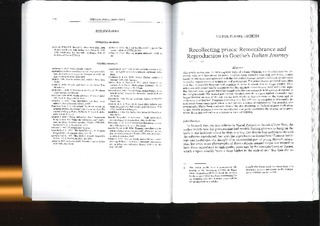Remembrance and Reproduction in Goethe's Italian Journey
Journal article, Peer reviewed
Published version

Date
2013Metadata
Show full item recordCollections
- Artikler / Articles [135]
- Publikasjoner fra Cristin - AHO [127]
Original version
Acta ad archaeologiam et artium historiam pertinentia. 2013, 26 139-163.Abstract
This article probes into the little explored topic of Johann Wolfgang von Goethe’s hunt for, obsession with, and dependence on prints. Goethe’s travel memoirs from Italy and Rome, written mostly in restrospect and published with the title Italian Journey, reveal a multitude of references to graphic reproductions of Roman art and architecture. The prints Goethe preferred were often ones that represented buildings and paintings in states in which they no longer existed. Thus, print not only helped Goethe remember, but they illustrate remembrance itself, and I shall argue that Goethe’s view on prints, therefore, complicates the conventionally held opinion of copying in the Enlightenment. The second part pursues Goethe’s attitude to copies further. Leonardo’s Last Supper became an icon of the age not the least thanks to Goethe’s essay on the fresco and his endorsement of Raphael Morghen’s engraving of it. The 19th-century reception of this rapidly deteriorating Renaissance masterpiece, in fact, outlines a notion of reproduction that precedes, also conceptually, Walter Benjamin’s reduction of the idea of copying to the level of mere duplication. In fact, Goethe endorses a creative reproduction that gently reanimates the original, so to speak, which this article will define as a historicist vision of copying.
